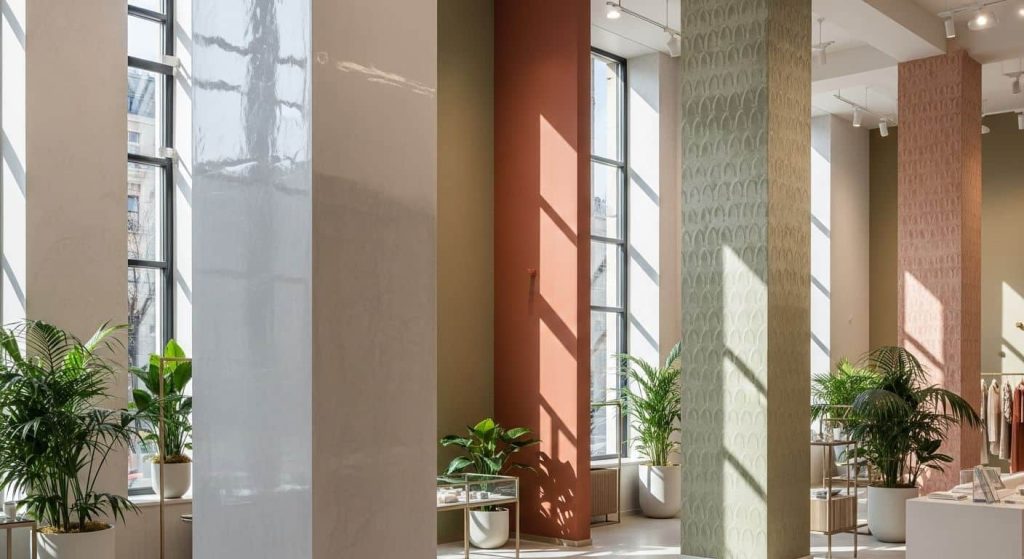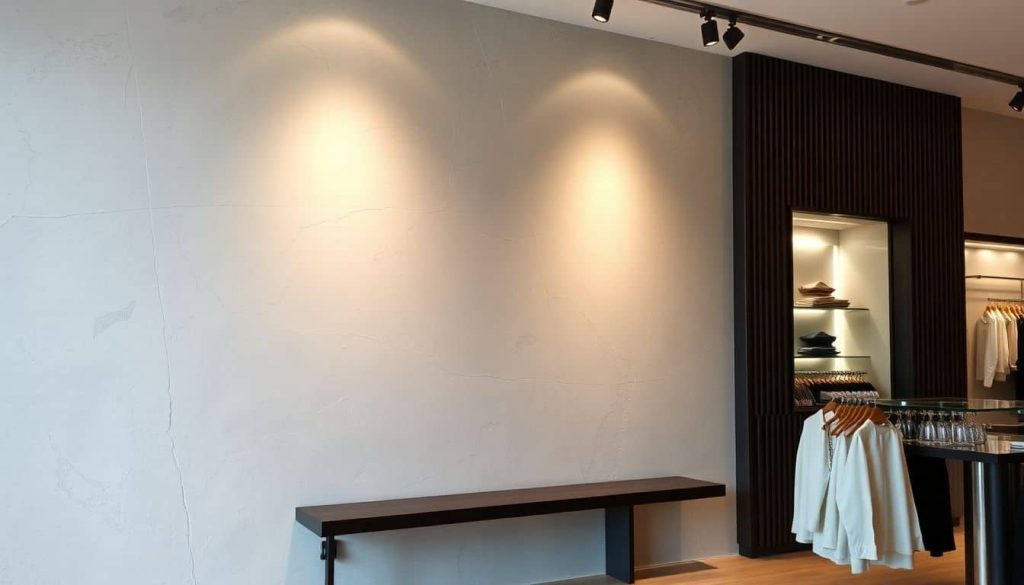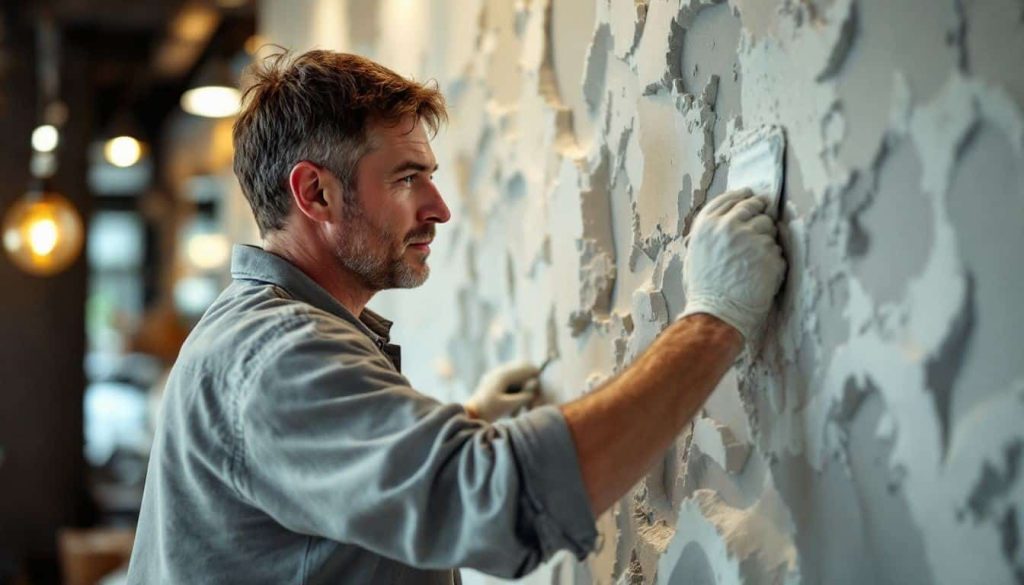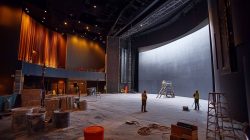Transform Your Retail Space with Stunning, Durable Plaster Finishes
Retail spaces often lack visual appeal. Modern plaster designs can change that. This blog will show you how to use plaster to boost your store’s look. Get ready to transform your retail space.
Key Takeaways
- Modern plaster offers 27 standard colors and custom mixes for retail spaces.
- Clay plaster helps control humidity and improves air quality in stores.
- Slaked lime plaster has been used for over 14,000 years and resists mold.
- Venetian plaster blends slaked lime, pigments, and marble dust for a polished look.
- Professional plastering ensures durability and can add unique textures to retail spaces.
The Role of Modern Plaster in Enhancing Retail Spaces

Modern plaster plays a key role in retail spaces. It adds beauty and function to stores, making them more appealing to shoppers.
Aesthetic Appeal and Design Flexibility
Modern plaster designs offer stunning looks for retail spaces. They come in 27 standard colors and custom mixes. Plaster walls create depth and texture, adding elegance to any store.
The smooth finish of Venetian plaster brings a high-end feel to shops.
Plaster is flexible for both old and new styles. It works well in minimalist designs and fancy settings. Stores can use it on walls, ceilings, and even floors. This versatility lets retailers create unique spaces that stand out.
Next, we’ll explore how plaster improves store acoustics.
Acoustic Benefits
Plaster’s beauty goes beyond looks. It also helps with sound. Plaster ceilings and walls absorb noise. This makes retail spaces quieter and more pleasant.
Stores with plaster have better acoustics. Customers can talk without shouting. Music sounds clearer. Plaster reduces echoes and outside noise. This creates a calm shopping environment.
Shoppers stay longer in comfortable, quiet stores.
Durability and Maintenance
Moving from acoustic benefits, let’s look at plaster’s strength and upkeep. Modern plaster walls last for decades. They resist cracks and chips better than drywall. Lime plaster stands out for its flexibility and long life.
It adapts to building shifts without breaking. This means fewer repairs over time.
Plaster needs little care to stay looking good. A quick wipe with a damp cloth keeps it clean. It doesn’t collect dust like some other wall finishes. This makes plaster great for retail spaces that need to look fresh.
High-traffic areas benefit from the plaster’s tough surface. It holds up well to daily wear and tear in busy stores.
Energy Efficiency
Plaster walls boost energy efficiency in retail spaces. They act as natural insulators, keeping heat in during winter and out in summer. This cuts down on heating and cooling costs.
Plaster also reduces air leaks, making the space more comfortable.
Modern plasters offer even better insulation. Some types include special additives that enhance their thermal properties. These advanced plasters can lead to significant energy savings over time.
Next, let’s explore the popular types of modern plaster for retail environments.
Popular Types of Modern Plaster for Retail Environments
Modern plaster comes in many types for retail spaces. Each type offers unique looks and benefits. Read on to learn about the top choices for your store.
Clay Plaster
Clay plaster brings natural beauty to retail spaces. It’s made from clay, sand, and pigments. This mix creates a unique look that catches the eye. Clay plaster also helps control humidity in stores.
This keeps the air fresh and comfortable for shoppers.
Clayworks, founded in 2002, leads the way in clay plaster design. Their work shines in places like the Douglas House in London. Many praise clay plaster for its health perks. It’s a smart choice for stores that want to stand out.
Next, we’ll explore slaked lime plaster and its benefits for retail environments.
Slaked Lime Plaster
Slaked lime plaster offers a smooth, durable finish for retail spaces. It’s made from lime, water, and sometimes sand. This mix creates a strong, breathable surface that resists mold and moisture.
Slaked lime plaster has been used for over 14,000 years, proving its lasting power.
Retail stores benefit from slaked lime plaster’s versatility. It can be tinted or textured to match any design style. The plaster also helps control indoor humidity and improves air quality.
For high-end shops, its elegant look adds a touch of luxury to walls and ceilings.
Gypsum Plaster
Gypsum plaster offers a smooth, durable finish for retail spaces. It dries quickly and resists fire, making it a safe choice. This plaster type allows for easy shaping and molding, perfect for creating unique designs.
Its naturally white color provides a great base for paint or other finishes.
Retail stores often use gypsum plaster for its versatility and cost-effectiveness. It helps control noise and maintains a comfortable indoor temperature. The material is lightweight yet strong, ideal for both walls and ceilings.
Gypsum plaster can be applied in thin layers, saving space in tight retail areas.
Venetian Plaster
Moving from gypsum, we find Venetian plaster. This unique finish blends slaked lime, pigments, and marble dust. It creates a smooth, polished look that’s both elegant and tough. Venetian plaster stands out in high-end retail and commercial spaces.
The Plywood House in Primrose Hill, North London shows off Venetian plaster’s charm. This project proves how the material can transform walls and ceilings. It adds depth and texture, making spaces feel rich and inviting.
Designers love it for its natural ingredients and low upkeep needs.
Tadelakt
Tadelakt is a unique Moroccan plaster finish. It’s made from lime and black olive soap. This mix creates a waterproof surface. Tadelakt works great in wet areas like showers and baths.
Its smooth texture and rich look add style to any space.
Retail stores can use Tadelakt to create eye-catching walls. The plaster’s water-resistant nature makes it perfect for high-traffic areas. It needs little upkeep, saving time and money.
Next, let’s explore the benefits of using modern plaster in retail spaces.
Neo Plaster
Neo Plaster brings a fresh twist to retail spaces. This modern plaster type mixes old-world charm with new-age tech. It uses acrylics for better-sticking power and toughness. You’ll need fewer coats to get a sleek look.
That means less work and faster results.
Shops love Neo Plaster for its style and smarts. It fights noise and saves energy. Plus, it’s tough enough to handle busy stores. You can shape it into cool designs or keep it smooth.
Either way, it’ll make your store stand out. Neo Plaster is perfect for stores that want to look good and work well.
The Advantages of Using Modern Plaster in Retail Spaces

Modern plaster brings many perks to retail spaces. It offers style, strength, and easy upkeep – all in one package.
Versatility in Design
Plaster offers endless design options for retail spaces. Its smooth surface takes on any color or texture, fitting various styles. Stores can create unique looks with plaster walls, from sleek modern to rustic charm.
The material adapts to curves and angles, allowing for creative shapes and patterns.
Plaster’s changing luminosity adds depth to retail interiors. It reflects light differently throughout the day, creating dynamic visual interest. This quality lets stores craft moods and highlight products effectively.
Plaster’s versatility makes it a top choice for designers seeking to craft standout retail environments.
Long-lasting Durability
Modern plaster stands out for its tough nature. It can last for decades with minimal upkeep. This material resists cracks, chips, and dents better than many other wall finishes. Retail spaces benefit from plaster’s strength, as it holds up well in high-traffic areas.
Shoppers won’t see worn-out walls, keeping the store looking fresh and inviting.
Plaster’s durability also saves money over time. Store owners spend less on repairs and repainting. The smooth surface of plaster makes it easy to clean, which is crucial in busy retail environments.
Next, let’s explore how plaster enhances cleanliness in stores.
Enhanced Cleanliness
Modern plaster designs boost cleanliness in retail spaces. Smooth surfaces resist dirt and dust buildup. This makes cleaning easier and less frequent. Plaster also fights mold and mildew growth.
Its natural properties keep spaces fresh and hygienic.
Clay plaster stands out for its health benefits. It’s perfect for people with chemical sensitivities. The material naturally purifies air and regulates humidity. This creates a healthier shopping environment.
Customers and staff alike benefit from improved air quality.
Artistic Freedom
Plaster gives designers the freedom to create unique looks. It molds into any shape or texture, letting stores stand out. The Birch & Clay Refugio in London shows this well. Its walls feature smooth curves and bold patterns made with plaster.
This material allows for endless design options, from sleek modern to rustic charm. Stores can match their brand image perfectly with custom plaster work.
Plaster also offers a canvas for art in retail spaces. Artists can carve, stamp, or paint directly on plaster walls. This turns plain surfaces into eye-catching focal points. Stores use this to tell their story or showcase local talent.
The result? Spaces that grab attention and keep customers coming back.
Practical Considerations and Challenges

Modern plaster brings challenges like tricky setup and upkeep costs. Want to learn more? Keep reading!
The Complexity of Application
Applying modern plaster to retail spaces needs skill and patience. The process involves three coats: scratch, brown, and finish. Each layer must dry fully before the next goes on. This takes time and expert hands.
The initial cost is higher due to the labor and materials needed. But the result is a smooth, durable surface that lasts for years.
Proper prep work is key to a good plaster job. Walls must be clean, dry, and free of cracks. The right tools and mix are crucial too. Plasterers use trowels, floats, and hawks to spread and smooth the material.
They must work fast before the plaster sets. Getting the texture just right takes practice and a keen eye for detail.
Maintenance and Repair Costs
Plaster walls need less upkeep than other materials. They resist wear and tear well. This means fewer repairs over time. Costs stay low because you don’t need to fix them often. Plaster’s durability saves money in the long run.
It’s a smart choice for busy retail spaces.
Cleaning plaster is easy and cheap. A damp cloth often does the job. For tougher stains, mild soap works well. No special cleaners are needed. This keeps ongoing costs down. Plaster’s smooth surface also helps.
It doesn’t trap dirt like some other wall types.
Comparison with Alternative Materials like Drywall
Modern plaster offers unique benefits compared to drywall in retail spaces. Here’s a quick comparison:
| Feature | Modern Plaster | Drywall |
| Cost | Higher upfront cost | Lower initial expense |
| Durability | More durable, lasts longer | Less durable, prone to damage |
| Soundproofing | Better sound insulation | Less effective for noise reduction |
| Aesthetics | Smooth, seamless finish | Visible seams and joints |
| Customization | Highly customizable textures and colors | Limited design options |
| Installation Time | Longer installation process | Quicker to install |
| Moisture Resistance | Better moisture resistance | More susceptible to moisture damage |
Modern plaster costs more at first but offers long-term value. It lasts longer and needs less repair. Drywall is cheaper to put up but may need more fixes over time. Plaster blocks sound better, making stores quieter. It looks smoother without seams. You can shape plaster in many ways for unique store designs. Drywall goes up faster but has fewer style options. In damp areas, plaster stands up better to moisture.
Installation Insights
Installing modern plaster in retail spaces needs skill and the right tools. Proper prep and technique are key for great results.
Necessary Tools and Equipment for Plastering
Plastering needs specific tools. A hawk holds plaster. A trowel spreads it. Mixing paddles blend materials. Scrapers smooth surfaces. Levels ensure even application. Sponges add texture.
Protective gear like gloves and goggles keep workers safe. Quality tools make the job easier and faster.
Good prep is key for great results. The next step is getting the space ready for plastering.
Preparing the Space for Plastering
Proper prep is key for good plastering. Clean walls thoroughly. Remove old paint, wallpaper, and loose debris. Fix any cracks or holes. Apply a bonding agent to smooth surfaces. Cover floors and furniture with drop cloths.
Mask off windows, doors, and fixtures. Ensure good ventilation in the room. Check that the surface is dry and free of dust.
The right tools make prep easier. You’ll need scrapers, sandpaper, and filler for surface fixes. A vacuum helps remove dust. Masking tape and plastic sheeting protect areas not being plastered.
With careful prep done, you’re ready to start applying plaster. Next, we’ll look at techniques for different textures and finishes.
Techniques for Achieving Different Textures and Finishes
Venetian plastering creates unique textures and finishes. Artisans apply thin layers of plaster with special tools. They use trowels, spatulas, and brushes to craft smooth or textured surfaces.
Each layer adds depth and character to the final look.
Modern plaster techniques offer many finish options. Smooth polished surfaces shine like marble. Rough textures mimic stone or concrete. Skilled workers can even create patterns or designs in the plaster.
These methods transform plain walls into eye-catching art pieces.
Understanding the Differences Between Traditional Plastering and EIFS/Stucco
Traditional plastering and EIFS/stucco differ in key ways. Traditional plaster uses lime or gypsum mixed with water and sand. It’s applied in layers to walls and ceilings. EIFS (Exterior Insulation and Finish System) is a modern system.
It uses foam insulation boards covered with a thin layer of synthetic stucco.
Lime plaster offers unique benefits. It prevents dampness and is eco-friendly. This makes it a top choice for many designers. EIFS, on the other hand, provides better insulation. It’s lighter and easier to install than traditional plaster.
Both options can enhance retail spaces. The choice depends on specific needs and design goals.
Venetian Plaster: An Eco-Friendly Wall Finish for Retail Environments
Moving from traditional plastering to eco-friendly options, Venetian plaster stands out. This finish uses natural materials like slaked lime, pigments, and marble dust. It creates a smooth, polished look that’s perfect for retail spaces.
Venetian plaster offers many benefits for stores. It’s durable and resists wear and tear. The finish is easy to clean, making it great for high-traffic areas. Plus, it’s free of harmful chemicals, so it’s safe for customers and staff.
The Plywood House project shows how beautiful Venetian plaster can look on walls.
The Importance of Professional Interior Plastering and Ceiling Restoration
Professional plastering ensures top-quality results in retail spaces. Experts bring skills and tools to create smooth, durable surfaces. They know how to mix and apply plaster for the best finish.
Indiana Wall Systems can also fix old plaster and ceilings, keeping the charm of historic buildings.
Good plastering adds value and style to any store. It creates a clean, modern look that draws customers in. Skilled workers can make unique textures and designs. They use safe methods and materials for a healthy space.
Proper plastering also helps with sound control and energy savings. Next, let’s wrap up our discussion on modern plaster in retail design.
Conclusion
Modern plaster designs transform retail spaces. They offer beauty, function, and eco-friendly options. Stores can choose from clay, lime, gypsum, or Venetian plaster. These materials create unique looks and boost sales.
Smart retailers use plaster to stand out and succeed.
FAQs
What makes Venetian plaster ideal for retail spaces?
Venetian plaster offers a unique, polished finish that adds sophistication to modern commercial spaces. It’s durable, versatile, and creates depth and texture – perfect for walls or ceilings in high-traffic areas.
How does plaster enhance interior design?
Plaster transforms spaces by adding elegance and character. It works in both traditional and contemporary designs, creating a sense of luxury. Plaster ceilings can change a room’s whole look.
Is Venetian plaster eco-friendly?
Yes! Made from natural lime and marble dust, Venetian plaster is an environmentally friendly choice. It has low volatile organic compounds, making it safe for indoor use.
How easy is it to maintain Venetian plaster?
Venetian plaster requires minimal upkeep. It’s resistant to everyday wear and tear, making it great for busy retail spaces. Regular dusting and occasional cleaning keep it looking fresh.
Can Venetian plaster be used on floors?
While less common, Venetian plaster can be applied to floors. It adds a unique touch but needs special sealing for foot traffic. It’s more often used on walls and ceilings.
Why do interior designers love Venetian plaster?
Designers favor Venetian plaster for its versatility and elegance. It suits various styles, from classic to modern. The material allows for creative finishes, adding depth and interest to any space.





